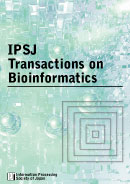Volume 4
Displaying 1-5 of 5 articles from this issue
- |<
- <
- 1
- >
- >|
-
Article type: Preface
Subject area: Preface
2011 Volume 4 Pages 1
Published: 2011
Released on J-STAGE: January 25, 2011
Download PDF (26K) -
Article type: Database/Software Papers
Subject area: Database/Software Paper
2011 Volume 4 Pages 2-8
Published: 2011
Released on J-STAGE: January 25, 2011
Download PDF (971K) -
Article type: Original Papers
Subject area: Original Paper
2011 Volume 4 Pages 9-20
Published: 2011
Released on J-STAGE: May 18, 2011
Download PDF (2490K) -
Article type: Original Papers
Subject area: Original Paper
2011 Volume 4 Pages 21-33
Published: 2011
Released on J-STAGE: November 04, 2011
Download PDF (706K) -
Article type: Original Papers
Subject area: Original Paper
2011 Volume 4 Pages 34-44
Published: 2011
Released on J-STAGE: December 14, 2011
Download PDF (637K)
- |<
- <
- 1
- >
- >|
